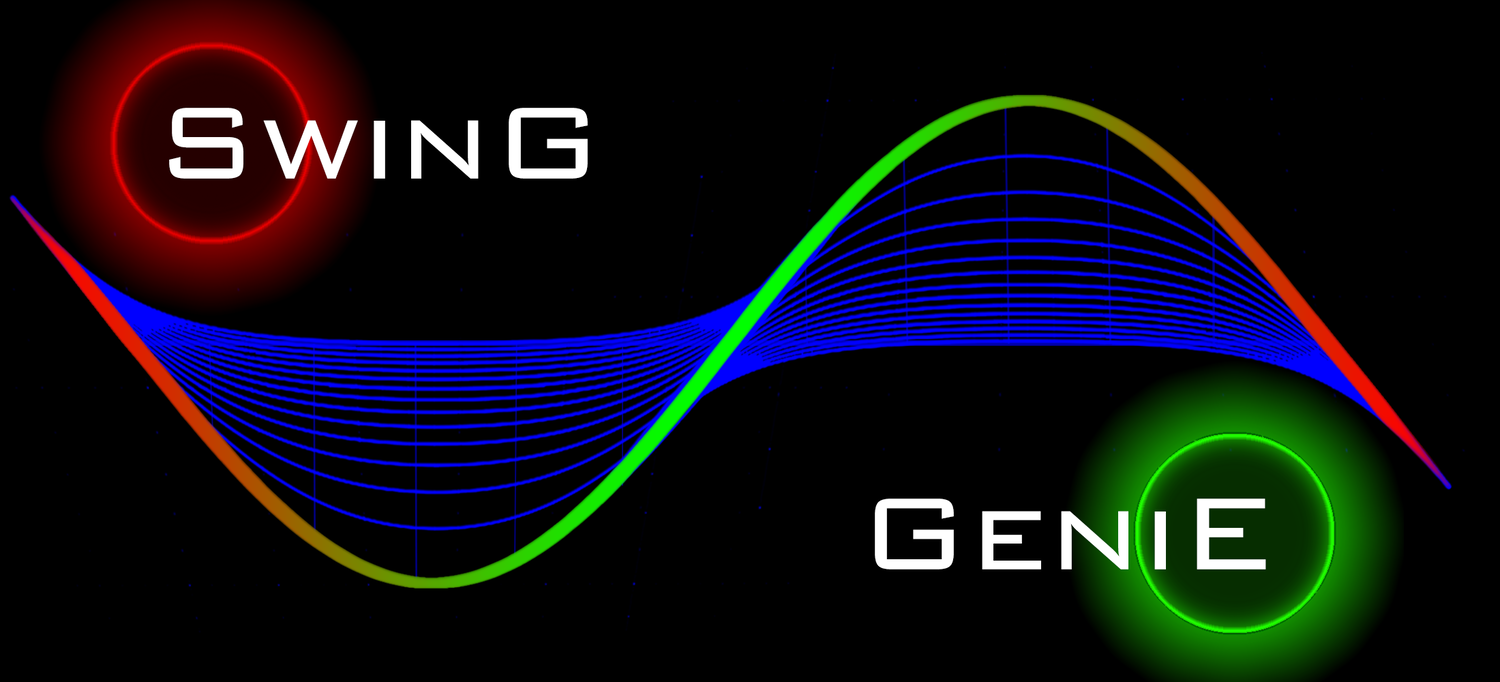The Pass Band Multi (PBM) indicator addresses the two most problematic, yet fundamental questions any stock trader must answer, over and over again. When to ENTER and EXIT your trades. Exiting a stock at the most opportune time, can be a multifaceted and stress filled decision summed up by;"Should I stay or should I go." Making these decisions smarter, more obvious and safer is achieved by PBM. The Pass Band Multi indicator utilizesunique combination of indicators, including crossover detection, oscillators, trend, volatility and momentum indicators as well as sentiment extraction all working synergistically to enable the user to take inconsistent market information and turn it into obvious, perceptive and profitable trading decisions.
PBM transforms volatile and conflicting candles into obvious and easy trading decisions. It’s this simple; stocks trending in an upward direction will be above the zero line (1) in the chart below. Stock trending downward will be below the zero line (2). Zero line crossovers are indicating turning points and trading opportunities (3). This gives you advanced warning of when your trades are approaching the next turning point, as the indicator will migrate back toward the zero line. Momentum, Volatility and Rate-of-Change are each unique and distinctive attributes of stocks in strong trends. The Pass Band Multi indicator provides the trader with a collective or merged indication of these attributes, all reflected by this indicator as the height or distance the Pass Band, sin-wave, signal line is from the zero line (4). When a stock’s PBM indicator advances rapidly, moving far above or far below the zero line you are seeing stocks in a strong trend with strong momentum. This strength and correspondingly the momentum will diminish over time in the absence of new market motivating factors such as rumors, news or earnings. As this occurs, the signal line will again drift down and approach the zero line even if the price has not moved against this most recent trend(5). This is a function of most oscillators and is referred to as detrending. The closer your trade comes to the zero line the more likely you are to see a reversal in the stock's price in the near future. The PBM signal moving inside the center band (gold lines/blue fill)(6) indicates to you that this upward momentum has neutralized and an exit may be required as the stock’s price approaches the zero line. If you have a strong convection of this stock’s long term potential, then you can hold the stock as long as the Pass Band signal does not move below the zero line. Stocks approaching the zero line, moving inside of the blue center band with gold boarders or tracking very near to the zero line indicate to traders that some action may be required by them to preserve capital in the near future. Short signals are exactly the opposite of the above description.
StockDotGenei’s, Pass-Band-Multi, indicator utilizes a unique combination of indicators, all working synergistically to enable the user to take inconsistent market information and turn it into obvious, perceptive and profitable trading decisions. The PBM gets you into a trade only after it has confirmed that this trade has both a pivot point and conformation of the new direction. The conformation is produced by the same, triple Laguerre crossover system, utilized in the Twists indicator. Exits are defined by both a crossover signal between two Laguerre filters and the PBM oscillator detrending and thus returning the indicator back to or near the zero pivot-point or crossover line. A more cautious exit point is after the PBM crosses into the center blue band, moving below the top gold line.
The Zero Line produces a demarcation between positive price trends and negative price trends. Each crossover occurs on or very near to the zero line. This requires that any stock trading above the zero line, be in an increasing price trend. Any dots below the zero line are experiencing a decreasing price trend. The distance the signal line is above or below the zero line indicates to the trader the strength of the trend by combining the volatility, rate of change and the amount of momentum this equity is experiencing.
The Twists Dot system is adopted from the TWISTS indicator and utilizes three Laguerre filters to produce a triple cross-over system. The TWISTS system is not looking to get you into a trade at the very first instance of a change in direction of the stock price. It only signals an entry opportunity after the trend has been confirmed. The use of Laguerre Polynomials to generate a filter structure similar to a simple moving average enables the creation of very short filters having the smoothing characteristics of much longer filters. Shorter filters mean less lag. Green dots indicate an uptrend, red dots a downtrend and gold dots are the intermediate first phase of the negative to positive crossover. You can enter a trade after any gold dot if the next dot is green or after a red dot when the next dot is green. You can read how the dots are calculated here. You can also read about John Ehlers’s Laguerre filters here. Adjusting the Laguerre filters also adjusts the Pass Band Filter, discussed next.
The Pass Band Filter produces the white sine wave signal line that the TWISTS dots are superimposed upon. As this line transverses the zero line and moves through the three bands providing the trader with valuable information about how their trade is performing. Each band's perimeter lines produce potential support and resistance levels.
A Pass Band Filter literally passes one short length Laguerre filter (gamma-1) through the longer length Laguerre filter (gamma-3). The Pass Band Laguerre oscillator removes very low and very high frequencies from the indicator, producing a smoother moving average with less lag and whipsaw actions. To set the indicator so that you remain in a trade increase the gamma-3 value in the indicators format panel. To enter a trade sooner decrease the gamma-1 value. Because you are adjusting the centerpoint of crossovers when adjusting the gamma values, the indicator may indicate these crossover or turning points slightly above or below the zero line instead of on the zero line. Additional information about Pass Band filters can be found here.
The bands with the dark blue or gold fills are produced utilizing the Root Mean Squared for X number of days back of the Pass Band Filter. This is weighted by the current sentiment that the equity is indicating from it’s Closing Score. The number of bars included in this look back, loop length, can also be changed within the formatting pallet under #1.
The bands provide the trader with an indication of both the rate of change, momentum and volatility by there width in relationship to prior periods.
A very conservative, safe and profitable trading strategy can be implemented by entering a stock when the TWISTS dots enter the blue band crossing above the lower gold line from below. You exit this swing trade when the stock's TWISTS dots again enters the blue band crossing below the upper gold line from above.
Moderate momentum, volatility and rates of change are indicated when the PBM enters the middle band.
When the PBM’s primary indicator line moves above or below the outer most bands’ demarcation line, it is indicating either an overbought or oversold situation and a reversal becomes much more likely. This has sometimes been referred to as irrational exuberance and it is a reflection of very strong momentum, volatility and a high rate of change.
This provides the trader with clearly indicated overbought and oversold indicators. When the Pass Band Filter line drops below the outer red / green lines (Root Mean Square adjustable lines) you are presented with a green background flag, indicating an oversold condition and a possible entry opportunity. Overbought is the opposite extreme and produces a red background flag indicating a possible exit signal. The caveat here is stocks can become overbought or oversold when news, events or earnings are influencing their price action and the price can be driven far beyond the initial overbought or oversold condition. You want to utilize these flags as your first indication that a potential change in direction could occur and utilize news and other indicators like TWISTS or StockDotGenie and Master Moving Average to confirm that this change in momentum will continue or reverse.
The outer top and bottom red or green lines are expanded dark red and dark green lines and are produced to allow the user to define the overbought and oversold levels. The normal range of this width is between 1.5 and 2 time the standard deviation of the dark red and dark green lines. You can change this width factor in the format pallet under #10. The outer most, upper and lower, red and green band lines are produced by calculating the Standard Deviation of the Root Mean Square of the Pass Band Filter.
When the price action of the equity being tracked move sideways it is considered to be consolidating. Because the stock is no longer trending you will start to see a contraction of all of the bands. When this consolidation is confirmed the blue filled center band will turn gold. This is an indication that an impending change is about to take place. The change can be a new leg in the same direction as the prior trend or a turning point changing the trend direction of this stock.
When the PBM moves below the outer band in a short period of time then an oversold flag will be generated. This produced a green background filled between the inner band and the outer band.
When the PBM moves above the outer band in a short period of time then an overbought flag will be generated. This produced a red background filled between the inner band and the outer band.
Increased volatility is indicated by expanding bands. This is a correlate of increasing momentum and an increase in the rate of change of this equity. Expanding bands is an indication of a newly trending equity.
Decreased volatility is indicated by contracting bands. This is a correlate of decreasing momentum and a decrease in the rate of change of this equity. Contracting bands are an indication of consolidation of an equities price range and indicates the pause or end of a trend.
The PBM acts an a Trending Indicator. As long as the trend is continuing/advancing you will see incremental increases or decreases in the Pass Band Filter’s dot system. When the trending stops, the dots will migrate back to the center- line of the indicator, unlike all simple, weighted or exponential moving averages that will track the price, offset by the length of the number of bars included in the average calculation. In what is admittedly an extreme example, an announcement of the sale of Heartware (HTWR) (image below) caused a dramatic increase in the share price from around $31 dollars (1) to the $58 level (2). See HTWR chart below. This was not followed by any significant change over the subsequent trading days as the price has been basically fixed by the buyout price. Looking at the Pass Band Multi indicator, you can clearly see the indicator interprets this price change as a dramatic change in momentum (3) and then, because no further change in price occurred the PBM indicator detrends, migrating back to the zero line (4). To the right of the (4) you can see that because the price no longer contained any volatility, the consolidation, gold background flag also becomes visible. The point of this extreem example is, when your stock, stops trending, the PBM will start moving toward the zero line unless and until some change in price circumvents this migration or creates a pivot point in a new trend direction. A simple trading rule for this indicator is: The closer your stock’s PBM is to zero, the more likely you are on the verge of a change in the rate of change or a reversal in price trend.
The primary indication utilized by traders of volatility is standard deviation. This is the average amount a stock price has changed from the mean in a given period of time. Most indicators that provide information about volatility incorporate the price as the basis for this calculation. It is very common to utilize a moving average price which is the source of the information utilized in Bollinger Bands to produce standard deviations line or bars. This enables us to visually see the volatility as width of the bands. The wider the bands the more volatile the price action of the stock you are examining. The SDG Pass Band Filter incorporates Laguerre filters as the base utilized to calculate the standard deviation after it has passed through a root mean square calculation producing the volatility bands you see in this indicator. The inner bands (gold lines with blue fill) are weighted by the Closing Score sentiment making them slightly wider in positive sentiment periods and slightly smaller in negative sentiment periods. The root mean square of a moving average or filter is considered to be the best volatility indicator. This is the topic of discussion in the October 2016 issue of Technical Analysis of Stocks and Commodities, in an article titled: "Trend Indicators; Which One Wins?" The outer band of this indicator are then drawn utilizing standard deviations of the root mean square of Laguerre filter. The outer bands producing the demarcation for overbought and oversold are adjustable in the formatting palette.
StockDotGenie’s “Pass Band Multi,” indicator informs traders if their stock is moving up or down, at what rate this is taking place and if it has moved with sufficient momentum into a stratified area where it is likely to reverse direction. The indicator also tells you when the opposite situation has occurred, moving from overbought or oversold into an area of congestion. It very accurately indicates to the trader when the stock’s current trend has lost it’s momentum, moving back toward the zero line, indicating that the trader should watch this stock very carefully for any indication that the trade is about to reverse direction. The default settings for this indicator are show below but changing the Short Gamma Length to zero (0), will get you into a trade sooner and setting the Long Gamma Length to (0.4) will get you out of a trade later. (10) enables you to adjust the outside Overbought and Oversold lines (Bright red and Green) allowing you some input into where the corresponding flags become visible.





























